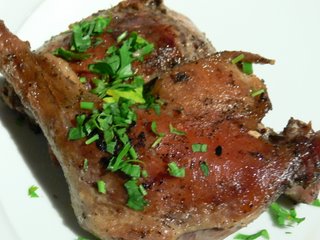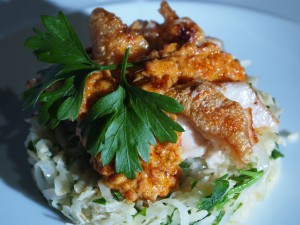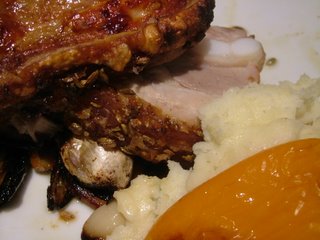 No photos of this one, since cassoulet à la Liz, once dished up, turns out to look totally unlovely; and I really don’t want to scare you off, because it tastes divine. I hope you made the duck confit (I have cunningly recycled the picture here from that recipe) from a few weeks back, which, along with its fat, forms an important part of this dish. If you didn’t, though, you can usually find tins of excellent Castelnaudry confit in good delis in the UK (I’ve also seen it in Waitrose).
No photos of this one, since cassoulet à la Liz, once dished up, turns out to look totally unlovely; and I really don’t want to scare you off, because it tastes divine. I hope you made the duck confit (I have cunningly recycled the picture here from that recipe) from a few weeks back, which, along with its fat, forms an important part of this dish. If you didn’t, though, you can usually find tins of excellent Castelnaudry confit in good delis in the UK (I’ve also seen it in Waitrose).
Cassoulet is one of those social-climbing dishes, which began life as a French peasant dish full of preserved meats and dried beans, and now gets sold for vast amounts of money in swish restaurants. You can buy tins of cassoulet, but a cassoulet you have made at home is even better, especially in mouth-feel. It’s a wonderfully warming dish, and it’s fantastic to serve to friends; somehow it’s an especially cheering and convivial thing to eat. You can serve it up as is, or with crusty bread and a salad. I’ve used Japanese panko breadcrumbs here, which are not at all French. I’m developing a slight addiction to them – wonderfully crisp, with a slightly malty flavour and a perfect balance between absorbency and crustiness, they’re terrific for topping baked dishes or making breaded coatings for baked or fried meats. If you can’t find any, normal white breadcrumbs, whizzed in your food processor, will be absolutely fine. If you’re in France, try to pick up some of the wonderful long, white haricot beans (haricots blancs lingots) which are traditionally used in cassoulet and have an amazingly creamy texture. They’re hard to find in the UK, so I have fallen back on standard haricots, which are a shorter bean. They are still excellent in this dish.
Thanks not least to Iris Murdoch (whose A Fairly Honourable Defeat, which contains a very stressful cassoulet incident, managed singlehandedly to put me off making cassoulet myself for about fifteen years), cassoulet has a bit of a reputation as a complicated, work-intensive dish. It’s really not all that bad; most of the work is done by your oven, with you stirring occasionally to help the slow-cooked beans become tender and creamy, and while there are short bursts of frying, skimming and stirring, you can easily fit all the other things you have to do in a day at around the long cooking time. Packed with moist pork belly, fat duck legs and garlicky sausage, this isn’t for days when you’re worrying about your blood pressure – as always, my philosophy on these things is that the rush of endorphins you get when eating something that tastes this good more than cancels out any health negatives, and hey – I understand beans are good for you.
To serve six, you’ll need:
500g haricot beans
2 large onions
2 sticks celery
1 carrot
5 cloves
1 bouquet garni
1 large sprig rosemary
1 large sprig thyme
3 bay leaves
6 fat cloves garlic
1 tablespoon herbes de provence
¼ bottle white wine
4 tomatoes, chopped roughly
400g slab pork belly
3 confit duck leg and thigh joints
6 garlicky sausages (if you can find saussice de Toulouse, they’re traditional here, but any very dense, meaty sausage will be good)
Japanese panko breadcrumbs OR bog-standard white breadcrumbs to sprinkle
The night before you want to eat, soak the beans in plenty of cold water. In the morning, drain the beans, discarding the soaking liquid, and put them in your largest casserole dish (you’ll need plenty of spare room in there for the cooking liquid, the other ingredients and the eventual swelling of the beans) with the bouquet garni, the rosemary and thyme, one of the onions, halved and studded with the cloves, the carrot, halved lengthways, one stick of the celery, two of the bay leaves and two of the garlic cloves, peeled and left whole. Chop the pork belly, complete with its rind, into 1 inch chunks, and add it to the saucepan. Pour over cold water to cover the contents of the pan by a couple of inches, and bring to the boil, skimming off any scum that rises to the surface.
When the pot is boiling, lower the heat to a simmer and put the lid on. Ignore it for an hour and a half while you brown the sausages in a tablespoon of the fat from the confit in a frying pan. Remove them to a plate, and use the sausage pan to fry the remaining onion, garlic and celery stick, chopped finely, until soft, in another large tablespoon of duck fat. Preheat the oven to 180° C.
Remove and discard the herbs and vegetables (except the garlic and the bouquet garni) from the beans mixture and drain and reserve the liquid (now stock) from the casserole dish. Return the beans and pork to the casserole, adding the onion, garlic and celery mixture, the chopped tomatoes, the remaining bay leaves, the sausages and the confit duck legs. (Don’t worry about scraping off any fat clinging to the legs – it’ll just add to the wonderful texture.) Pour over the wine and add the reserved stock from the pork and beans to just cover the mixture. Add a tablespoon of salt. Bring the contents of the casserole to a simmer on the hob and put it in the oven for two hours with the lid on, stirring every half an hour.
When the two hours are up, there should be no visible liquid; the whole cassoulet should have an even, creamy texture. Taste for seasoning – you will probably need to add extra salt. Sprinkle the top of the cassoulet with the panko crumbs or breadcrumbs, and cook for another 20-30 minutes with the lid off, until the crumbs are brown and the cassoulet is bubbling through it in places. Serve up, making sure everyone gets a bit of duck, a bit of sausage, and a bit of pork with their creamy beans and crusty top.




